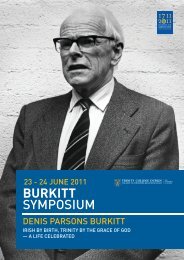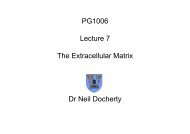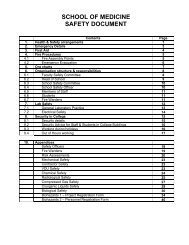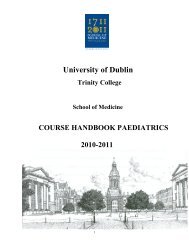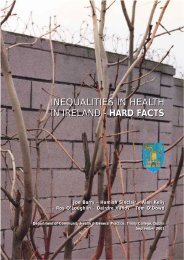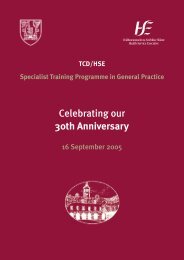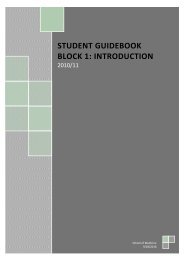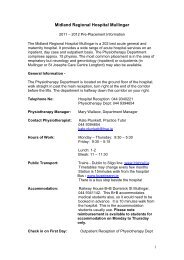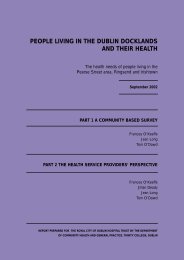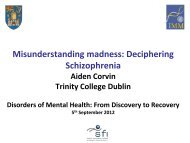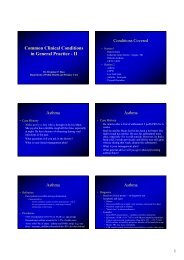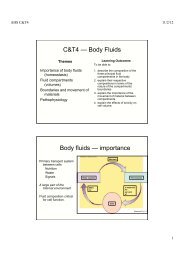Heart-Failure-Cardio..
Heart-Failure-Cardio..
Heart-Failure-Cardio..
Create successful ePaper yourself
Turn your PDF publications into a flip-book with our unique Google optimized e-Paper software.
<strong>Heart</strong> <strong>Failure</strong><br />
<strong>Cardio</strong>myopathy<br />
Sudden Cardiac Death<br />
Dr Deirdre Ward<br />
Consultant <strong>Cardio</strong>logist
<strong>Heart</strong> failure<br />
• Broad descriptive term which includes:<br />
• Left ventricular systolic impairment<br />
• Left ventricular diastolic impairment<br />
• Biventricular systolic impairment<br />
• Right ventricular systolic impairment<br />
• Prevalence<br />
• approx 1% total population<br />
• 4-5% of population > 70 years<br />
• > 40,000 patients<br />
• Prevalence probably increasing as mortality from<br />
heart disease reduces<br />
• Most common discharge diagnosis in > 65s in USA
<strong>Heart</strong> <strong>Failure</strong> - Outcome<br />
• Annual mortality is 15-20%<br />
• From time of diagnosis 50% 5 year<br />
survival<br />
• Morbidity high<br />
• Of those discharged from hospital with heart<br />
failure 30% will be readmitted in 3 months
Causes of <strong>Heart</strong> <strong>Failure</strong><br />
• Ischaemic heart disease<br />
• Valvular heart disease<br />
• Hypertension<br />
• Inherited cardiomyopathy<br />
• Congenital heart disease<br />
• Infection<br />
• Myocarditis, endocarditis, rheumatic fever<br />
• Pericardial disease<br />
• Infiltrative (sarcoid(<br />
sarcoid, , TB, haemochromatosis, metastatic<br />
cancers)<br />
• Other :<br />
• Tachycardia<br />
• Peri-partum<br />
• COPD / OSA
Symptoms of heart failure<br />
• Symptoms<br />
• Fatigue<br />
• Shortness of breath on exertion<br />
• Orthopnoea<br />
• Paroxysmal nocturnal dyspnoea<br />
• Palpitations<br />
• Diziness, , syncope<br />
• Angina
NYHA Classification of Symptoms<br />
• Class I – no limitation of physical activity<br />
• Class II – slight limitation of physical<br />
activity, comfortable at rest<br />
• Class III – marked limitation of physical<br />
activity, comfortable at rest<br />
• Class IV – symptoms at rest
Signs of left heart failure<br />
• Gallop rhythm<br />
• Lung crepitations<br />
• Displaced apex beat<br />
• Pleural effusions<br />
• Signs of underlying cause<br />
• Valvular heart disease, hypertension etc
Signs of right heart failure<br />
• Elevated JVP<br />
• Ankle oedema (JVP should be up 4cms)<br />
• Cave venous insufficiency, Ca antagonist Rx<br />
• Ascites
Diagnosis of <strong>Heart</strong> <strong>Failure</strong><br />
• Clinical history<br />
• ECG<br />
• Often non-specific changes or fairly normal<br />
• Previous MI, acute ischaemic changes<br />
• Hypertensive changes or cardiomyopathy<br />
• Tachyarrhythmia
Echo in <strong>Heart</strong> failure<br />
• LV size<br />
• Systolic function<br />
• Regional vs global wall motion abnormality<br />
• Valvular heart disease<br />
• LV diastolic function<br />
• Mitral valve inflow<br />
• Pulmonary vein flow<br />
• Tissue Doppler velocity<br />
• Right heart size and function
Other investigations<br />
• Chest X-rayX<br />
• Blood tests<br />
• BNP (pro-BNP,<br />
NTproBNP)<br />
• Anaemia<br />
• Thyroid function tests<br />
• Renal profile<br />
• Diabetes<br />
• Liver profile, coagulation (right heart failure)<br />
• Coronary angiography<br />
• ? Viral screen, family evaluation etc
Management – systolic impairment<br />
• Acute management – stable patient<br />
• Oxygen<br />
• Diuretic therapy (loop +/- thiazide)<br />
• Treat any treatable causes (ischaemia, TFTs anaemia)<br />
• ACE inhibitor<br />
• +/- morphine and nitrate<br />
• Acute management – unstable patient<br />
• Positive airway pressure oxygen<br />
• Diuretic<br />
• +/- morphine and nitrate<br />
• Consider intubation and ventilation
Long-term management – systolic<br />
• Symptom relief<br />
impairment<br />
• Diuretics – loop +/- thiazide<br />
• Digoxin – even in sinus rhythm<br />
• Prognostic benefit<br />
• ACE inhibitors (uptitrate(<br />
slowly)<br />
• Beta-blockers (start after diuretics reduced or<br />
withdrawn, uptitrate gradually)<br />
• Aldosterone antagonist<br />
• Angiotensin receptor blockers (meta-analysis<br />
analysis<br />
suggests not in combination with ACE i)<br />
• Hydralazine and nitrates
Long-term management – other<br />
• Diastolic dysfunction<br />
issues<br />
• Symptomatic improvement with diuretic therapy<br />
• Caution not to over-diurese<br />
• No drug therapy of proven prognostic benefit<br />
• Right heart failure<br />
• Diuretic therapy - spironolactone<br />
• Remove exacerbating elements (eg OSA)<br />
• Pleural / ascitic tap
Non-pharmacological Rx<br />
• Exercise<br />
• Restrict salt intake<br />
• ? Reduce fluid intake (controversial)<br />
• Reduce excessive weight<br />
• <strong>Heart</strong> failure clinics
Invasive therapy<br />
• Biventricular pacemaker (CRT)<br />
• Broad QRS<br />
• NYHA Class III or IV (? Less now)<br />
• ‘dyssynchrony’ echo<br />
• ICD – often with above<br />
• EF < 30-35% 35% after 4 (or 12) weeks optimal therapy<br />
• LVAD<br />
• Cardiac Transplantation
Cardiac resynchronisation therapy
Inherited cardiomyopathy<br />
Sarcomere<br />
mutation<br />
Nuclear envelope<br />
Cytoskeleton<br />
Sarcomere<br />
Cell adhesion gene
Prevalence<br />
Estimated no<br />
affected in Ireland<br />
HCM 1:500 9,000<br />
ARVC 1:1,000 - 10,000 900<br />
DCM 1:3,000 - 5,000 900-1500
HCM – under a microscope
Genetic causes
Genetics of HCM<br />
• 90 % cases are Autosomal Dominant<br />
• Autosomal = not on X or Y chromosomes<br />
• Dominant = only one ‘abnormal’ copy of gene<br />
required to cause condition<br />
• 50 % chance of affected person passing on<br />
‘abnormal’ gene to each of their children<br />
• Incomplete penetrance<br />
• Not everyone who inherits gene will develop<br />
symptoms and signs of the condition<br />
• 10 % ‘Sporadic’ – ie no family history of HCM
How do people present<br />
• Symptoms :<br />
• Chest pain<br />
• Shortness of breath<br />
• Palpitations<br />
• Pre-syncope / syncope<br />
• Cardiac arrest<br />
• No symptoms :<br />
• Incidental finding<br />
• Family screening
How is HCM diagnosed<br />
• History<br />
• Physical exam (‘jerky(<br />
jerky’ pulse, systolic murmur left<br />
sternal edge)<br />
• ECG (LVH +/- ST segment and T-wave T<br />
changes)<br />
• Transthoracic Echo<br />
• +/- <strong>Cardio</strong>pulmonary exercise test<br />
• +/- MRI<br />
• +/- Genetic testing
Complications of HCM<br />
• None<br />
• Chest pain<br />
• LVOT obstruction<br />
• Atrial fibrillation<br />
• Thrombo-embolic events (strokes)<br />
• <strong>Heart</strong> failure<br />
• Cardiac arrest
Management of HCM<br />
• Symptom control<br />
• B-blockers<br />
• Verapamil<br />
• Negative inotropes (LVOT obstruction)<br />
• <strong>Heart</strong> failure therapy<br />
• Anticoagulation<br />
• Septal reduction therapy (alcohol septal ablation vs<br />
surgical myectomy)<br />
• Transplant
HCM Management<br />
• Genetic aspects<br />
• First degree relatives evaluated with ECG and<br />
Echo<br />
• 12-18 18 year-old annually<br />
• Thereafter 2-52<br />
5 yearly<br />
• Genetic testing<br />
• Sudden death risk
Magnitude of Sudden Cardiac Death in HCM<br />
50 % HCM<br />
1.4%<br />
Percentage SCD<br />
in HCM<br />
Causes of SCD<br />
in the Young
Who is at risk?<br />
• Features that may indicate increased risk :<br />
• Previous cardiac arrest<br />
• Family history premature sudden death<br />
• Unexplained blackouts<br />
• Abnormal rhythm on exercise test or Holter monitor<br />
(even 3 beats of ventricular tachycardia)<br />
• Blood pressure fails to rise normally with exercise<br />
• Severe thickening of the heart (>3 cms or almost 3x<br />
normal)<br />
• Some more significant at younger age<br />
• Presence of LVOTO may also increase risk<br />
• Presence of fibrosis as indicated by late<br />
enhancement post contrast on cardiac MRI
Inherited DCM<br />
• 7-25% of ‘Idiopathic’ DCM may be familial<br />
• Sometimes associated with more<br />
generalised myopathies (eg muscular<br />
dystrophies)<br />
• Genetic causes may exceed 100 genes<br />
• Presence of conduction disease may<br />
suggest specific subtypes<br />
• Management same as for heart failure
Arrhythmogenic right ventricular<br />
cardiomyopathy (ARVC)<br />
• Commonest cause of SCD in athletes in<br />
Northern Italy.<br />
• Prevalence 1:1000 (or 1 in 5000).<br />
• Familial in 30-40% of cases (or > 90%)<br />
• Fibrofatty replacement of the right<br />
ventricle.<br />
• Fatal ventricular arrhythmias of right<br />
ventricular origin.
Treatment of ARVC<br />
• Asymptomatic, normal pump function, no<br />
abnormal rhythms detected : No<br />
Treatment<br />
• Palpitations : Beta-blockers or Amiodarone<br />
• Reduced pump function : ACE inhibitors,<br />
Spironolactone, , diuretics etc<br />
• High risk : Implantable defibrillator<br />
• End-stage pump failure : transplant
Sudden Cardiac Death<br />
• Sudden Cardiac Death = death from<br />
definite or probable cardiac causes within<br />
1 hour of symptom onset<br />
• Incidence from International Studies<br />
• 1 to 3 per 100,000 in those 1 to 35 yrs of age<br />
• 10 to 75 per 100,000 in those 35 to 64 yrs<br />
• Incidence in Ireland unknown<br />
• Extrapolation from other studies suggest<br />
• > 5,000 SCD annually RoI, , >2000 NI<br />
• > 60 deaths < 35 yrs (RoI(<br />
RoI), >25 (NI)
Causes of SCD<br />
• Over 35 yrs of age, Coronary <strong>Heart</strong><br />
Disease is most common cause<br />
• Under 35 yrs<br />
• <strong>Cardio</strong>myopathies<br />
• Congenital <strong>Heart</strong> Disease<br />
• ‘Structurally Normal <strong>Heart</strong>’ (ion channel<br />
disorders, conduction disease)<br />
• Anomalous coronaries
Sudden Adult Death Syndrome<br />
• Cause not apparent on PM<br />
• Cave potentially spurious causes<br />
• Non-obstructive obstructive coronary disease with no<br />
infarct<br />
• ‘LVH’ with normal heart weight<br />
• ‘sudden death in epilepsy’<br />
• 40% of families have inherited cause<br />
identified (mostly LQT and Brugada)
Long QT syndrome<br />
• Inherited form 1 in 5000<br />
• Up to 7 genes associated<br />
• Up to 75 % have LQT1(35-40%),2 (30-35) 35) or 3<br />
(10%)<br />
• Patients present with syncope or sudden death<br />
due to polymorphic ventricular tachycardia<br />
(torsades<br />
de pointes)<br />
• LQT1 events occur with exercise or emotion<br />
• swimming<br />
• LQT2 events occur with ‘startle’<br />
• LQT3 events occur at rest or during sleep
Management LQT<br />
• Avoid precipitants<br />
• Medications<br />
• Stimulants<br />
• Exercise (LQT types 1 and 2)<br />
• B-blockers<br />
• LQT type 1 and 2<br />
• ICD
Brugada Syndrome<br />
• Prevalence unknown<br />
• May be significant regional variation<br />
• Association of incomplete RBBB in right<br />
precordial leads with ST segment elevation and<br />
sudden death<br />
• ‘Concealed’ cases may be unmasked by<br />
provocation tests<br />
• Management<br />
• At risk if syncope or spontaneously abnormal ECG<br />
• ICD currently only available treatment
Other causes SCD<br />
• Myocarditis<br />
• Catecholaminergic Polymorphic VT<br />
• Congenital heart disease<br />
• Questionable causes<br />
• Anomalous coronaries<br />
• MVP<br />
• Sudden death in epilepsy
Summary<br />
• <strong>Heart</strong> failure widespread<br />
• Prognosis still poor, but intensive<br />
management improves<br />
• SCD in the young is rare but causes<br />
under-recognised<br />
recognised<br />
• Specialist centre for evaluation of and<br />
management of those at risk in Tallaght<br />
• Made possible by your hard work!!



